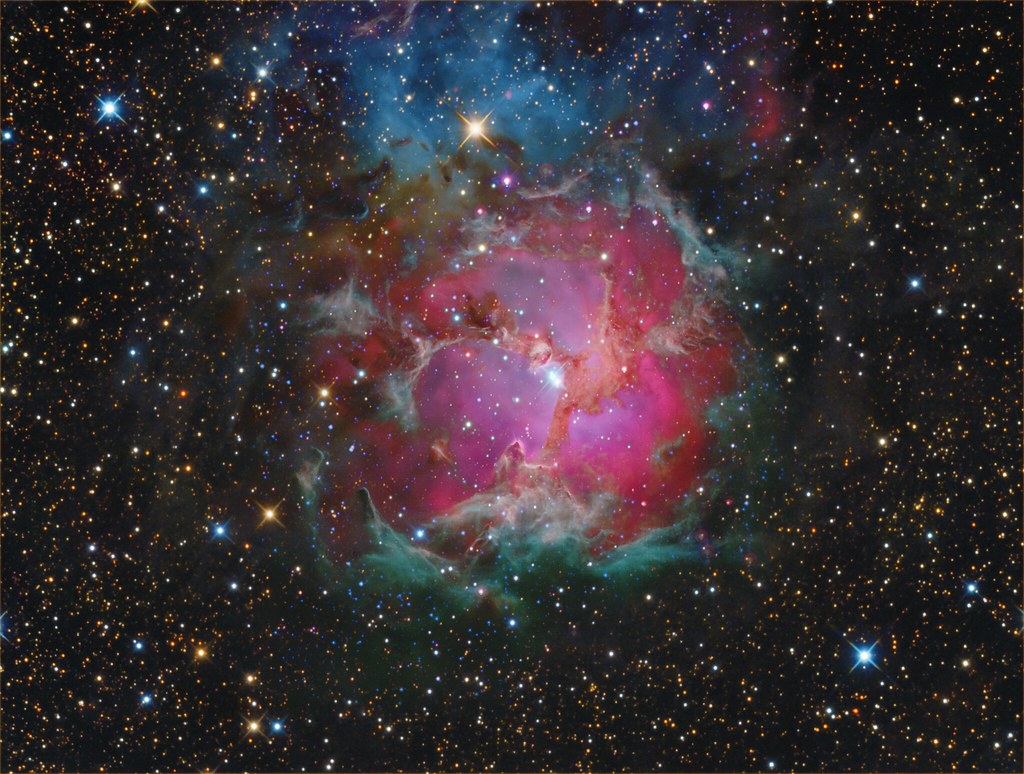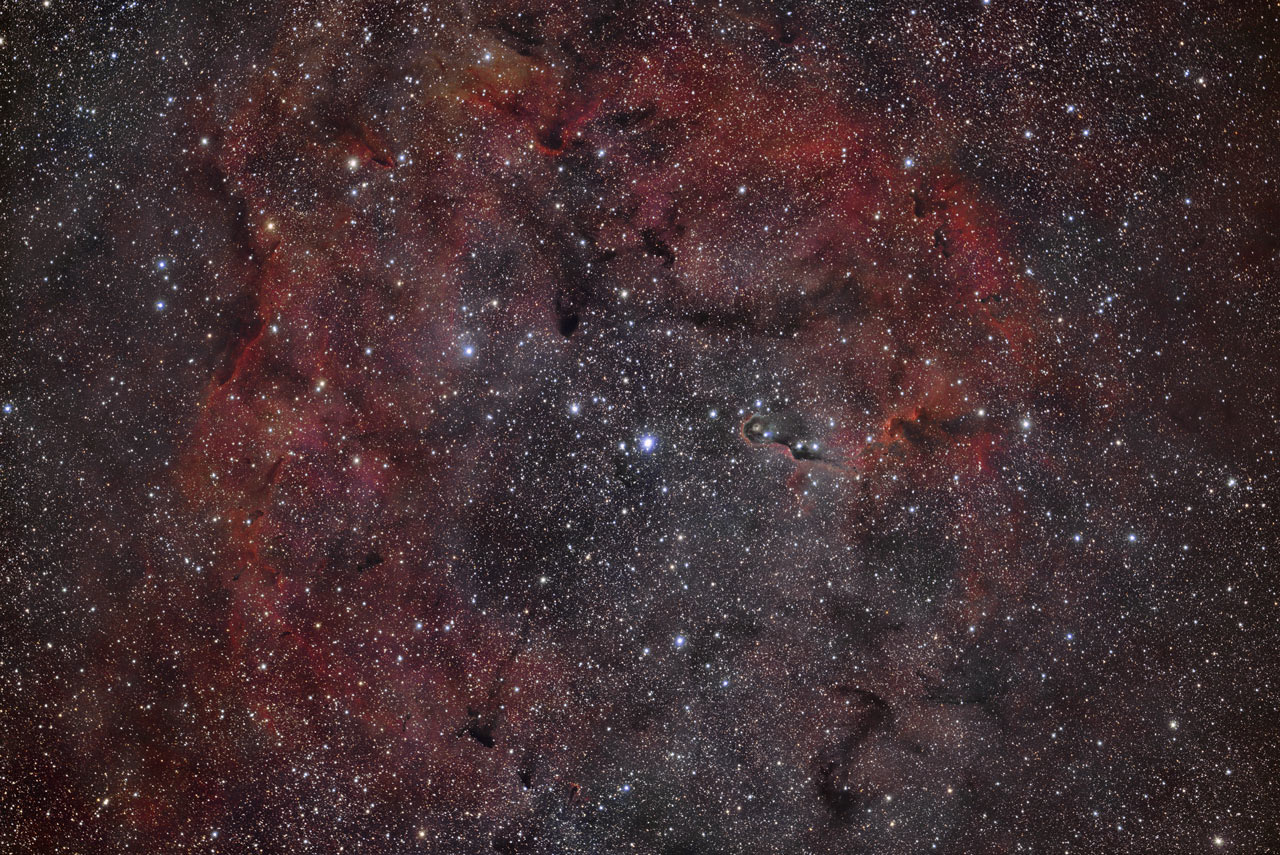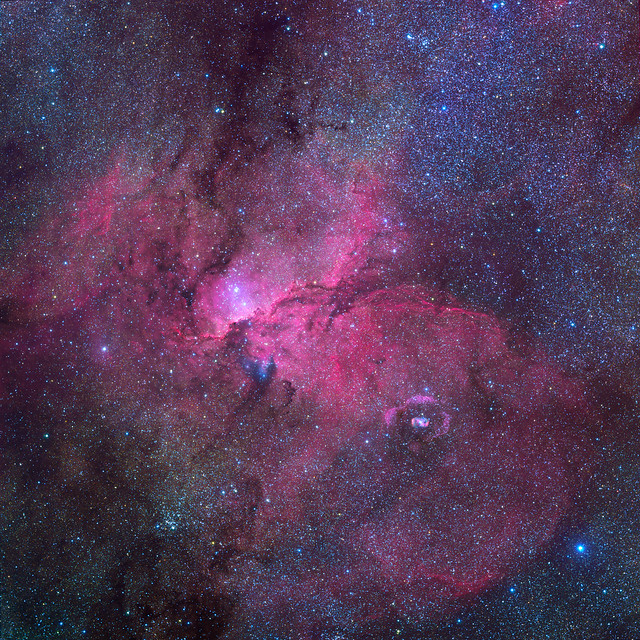Submissions: 2018 July
-
Slawomir
- Ensign
- Posts: 26
- Joined: Mon Apr 20, 2015 4:40 am
- AKA: Suavi
- Location: Proserpine Australia
- Contact:
Re: Submissions: 2018 July
M17 in SHO
https://www.astrobin.com/users/Slawomir/
Copyright: Slawomir Lipinski
Full resolution: https://cdn.astrobin.com/thumbs/06gUy65 ... t6vfvn.jpg
https://www.astrobin.com/users/Slawomir/
Copyright: Slawomir Lipinski
Full resolution: https://cdn.astrobin.com/thumbs/06gUy65 ... t6vfvn.jpg
-
Deep-Sky-Astroteam
- Ensign
- Posts: 54
- Joined: Tue Aug 26, 2014 9:01 am
- Location: Berlin - Germany
- Contact:
Re: Submissions: 2018 July
IC 2948/2944, Center of the Running Chicken Nebula
Copyright: Nico Geisler, Gorden Konieczek, Frank Iwaszkiewicz (Deep-Sky-Astroteam) https://www.deep-sky-astroteam.de/en/Ne ... ken-nebula
Copyright: Nico Geisler, Gorden Konieczek, Frank Iwaszkiewicz (Deep-Sky-Astroteam) https://www.deep-sky-astroteam.de/en/Ne ... ken-nebula
-
rwittich_de
- Ensign
- Posts: 78
- Joined: Thu Feb 03, 2011 12:53 pm
- Contact:
Re: Submissions: 2018 July
North America and Pelican Nebula
Data and higher resolution: https://www.wittich.com/?p=2610
Enjoy the First Light with my RASA 11 and my first image with a one shot color camera
Data and higher resolution: https://www.wittich.com/?p=2610
Enjoy the First Light with my RASA 11 and my first image with a one shot color camera
Re: Submissions: 2018 July
Storm under the stars
It's storm season here in Quebec city , Canada.
I've been lucky to have this sorm passing slowly infront of me and to see the stars at the same time
You can recognize the big dipper and polaris star.
It was on july 2 , 2018.
To see more images , its here http://flickr.com/dominiccantin
It's storm season here in Quebec city , Canada.
I've been lucky to have this sorm passing slowly infront of me and to see the stars at the same time
You can recognize the big dipper and polaris star.
It was on july 2 , 2018.
To see more images , its here http://flickr.com/dominiccantin
-
Mauro Rorato
- Ensign
- Posts: 15
- Joined: Tue Jan 20, 2015 9:07 am
Re: Submissions: 2018 July
https://www.flickr.com/photos/162902024 ... ed-public/
http://themaurosky.wixsite.com/astrophotography/m20-1
https://static.wixstatic.com/media/d3e3 ... 08~mv2.png
https://static.wixstatic.com/media/d3e3 ... 08~mv2.png
M20 The Trifid Nebula (catalogued as Messier 20 or M20 and as NGC 6514) is an H II region located in Sagittarius ,
The Trifid Nebula is a star-forming region in the Scutum spiral arm of the Milky Way.[5] The most massive star that has formed in this region is HD 164492A, an O7.5III star with a mass more than 20 times the mass of the Sun.[6] This star is surrounded by a cluster of approximately 3100 young stars.[7]
In this version we can see inside the dark nebulosity through the MIPS 24um frequencies; 5,8um; 4,5um -Spitzer-
http://themaurosky.wixsite.com/astrophotography/m20-1
https://static.wixstatic.com/media/d3e3 ... 08~mv2.png
https://static.wixstatic.com/media/d3e3 ... 08~mv2.png
M20 The Trifid Nebula (catalogued as Messier 20 or M20 and as NGC 6514) is an H II region located in Sagittarius ,
The Trifid Nebula is a star-forming region in the Scutum spiral arm of the Milky Way.[5] The most massive star that has formed in this region is HD 164492A, an O7.5III star with a mass more than 20 times the mass of the Sun.[6] This star is surrounded by a cluster of approximately 3100 young stars.[7]
In this version we can see inside the dark nebulosity through the MIPS 24um frequencies; 5,8um; 4,5um -Spitzer-
Last edited by bystander on Wed Jul 11, 2018 7:06 pm, edited 1 time in total.
Reason: Please, no hotlinks to images > 500Kb. Substituted lower resolution jpg image from flickr.
Reason: Please, no hotlinks to images > 500Kb. Substituted lower resolution jpg image from flickr.
Re: Submissions: 2018 July - NGC7023 Iris Nebula
One of the most beautiful and fascinating structures in the northern sky: NGC 7023, Iris Nebula is a diffuse nebula the northern constellation of Cefeo. It is about 1400 light years from us and is characterized by an apparent magnitude of 7.7. It is a reflection nebula reflecting the light of some nearby stars.
Taken on several nights of summer 2018, from our personal remote observatory 3Z @astrocamp, Manciano (italy).
Instrumentations: RC8 GSO - G24000 Moravian on EQ6 Skywatcher
Shooting data:
L 35x900s bin1 (9 hours)
Red 14x600s bin1 (2.3 hours)
Green 15x600s bin1 (2.5 hours)
Blue 20x600s bin1 (3.3 hours)
Flat, dark and bias
Made and processed by Paolo Zampolini and Giorgio Mazzacurati
Observatory site:https://sites.google.com/view/3zobserva ... c7023-iris
Taken on several nights of summer 2018, from our personal remote observatory 3Z @astrocamp, Manciano (italy).
Instrumentations: RC8 GSO - G24000 Moravian on EQ6 Skywatcher
Shooting data:
L 35x900s bin1 (9 hours)
Red 14x600s bin1 (2.3 hours)
Green 15x600s bin1 (2.5 hours)
Blue 20x600s bin1 (3.3 hours)
Flat, dark and bias
Made and processed by Paolo Zampolini and Giorgio Mazzacurati
Observatory site:https://sites.google.com/view/3zobserva ... c7023-iris
Last edited by Ilpool187 on Thu Jul 12, 2018 4:31 pm, edited 1 time in total.
-
Ariel_Gustavo
- Asternaut
- Posts: 1
- Joined: Thu Jul 12, 2018 1:32 am
Re: Submissions: 2018 July
Hi!
This is my first post. It's an image from the Rho Ophiuci / Antares zone.
It was taken in San Antonio de Areco, Argentina on June 17, 2018.
Antares reflection was unavoidable...
24 lights 300 seconds each (2 hours) ISO 800
10 darks
100 bias
Equipment:
Skywatcher Esprit APO 100
Modified Canon 6D
HEQ5 Pro mount guided with QHY5L-II and PHD2
I used Pixinsight as processing software.
Hope you like it!
Rho Ophiuci
Copyright: Ariel Gustavo Saleh
This is my first post. It's an image from the Rho Ophiuci / Antares zone.
It was taken in San Antonio de Areco, Argentina on June 17, 2018.
Antares reflection was unavoidable...
24 lights 300 seconds each (2 hours) ISO 800
10 darks
100 bias
Equipment:
Skywatcher Esprit APO 100
Modified Canon 6D
HEQ5 Pro mount guided with QHY5L-II and PHD2
I used Pixinsight as processing software.
Hope you like it!
Rho Ophiuci
Copyright: Ariel Gustavo Saleh
21P/Giacobini-Zinner
Copyrights.
Capture: Raul Villaverde Fraile, Domingo Pestana & Nicolas Romo
Process: Raul Villaverde
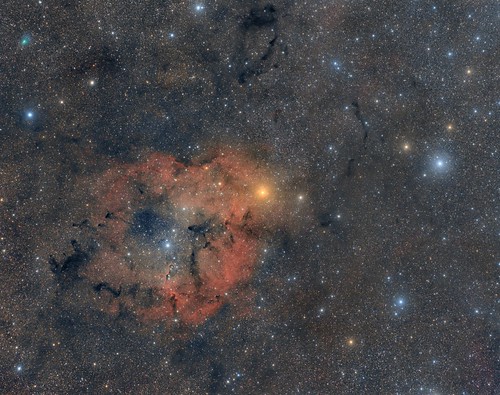 21P:Giacobini-Zinner by Raul Villaverde, en Flickr
21P:Giacobini-Zinner by Raul Villaverde, en Flickr
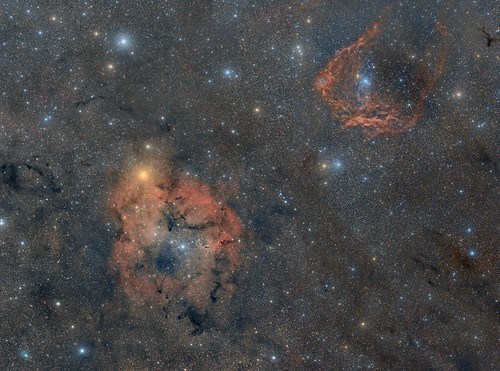 IC1396&Sh2-129&COMET by Raul Villaverde, en Flickr
IC1396&Sh2-129&COMET by Raul Villaverde, en Flickr
Capture: Raul Villaverde Fraile, Domingo Pestana & Nicolas Romo
Process: Raul Villaverde
 21P:Giacobini-Zinner by Raul Villaverde, en Flickr
21P:Giacobini-Zinner by Raul Villaverde, en Flickr IC1396&Sh2-129&COMET by Raul Villaverde, en Flickr
IC1396&Sh2-129&COMET by Raul Villaverde, en Flickr-
rwittich_de
- Ensign
- Posts: 78
- Joined: Thu Feb 03, 2011 12:53 pm
- Contact:
Re: Submissions: 2018 July
-
kokehtz
- Ensign
- Posts: 50
- Joined: Sun Mar 17, 2013 11:49 pm
- AKA: AIP
- Location: Madrid, Spain
- Contact:
Re: Submissions: 2018 July
Collinder 399
Autor: Álvaro Ibáñez Pérez
Website: www.aipastroimaging.com
Full resolution:
https://aipastroimaging.com/wp-content/ ... 00_AIP.jpg
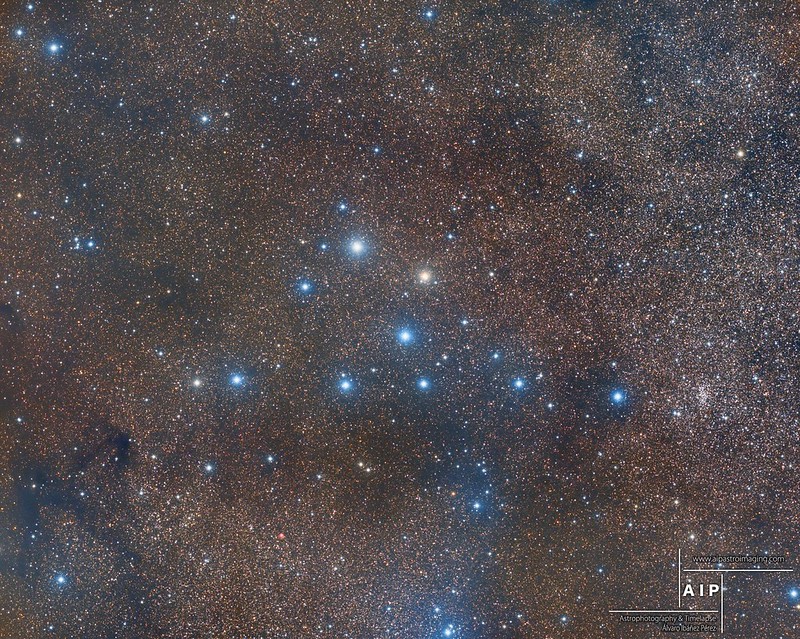
Annotated:
https://c2.staticflickr.com/2/1801/2940 ... 9349_o.png
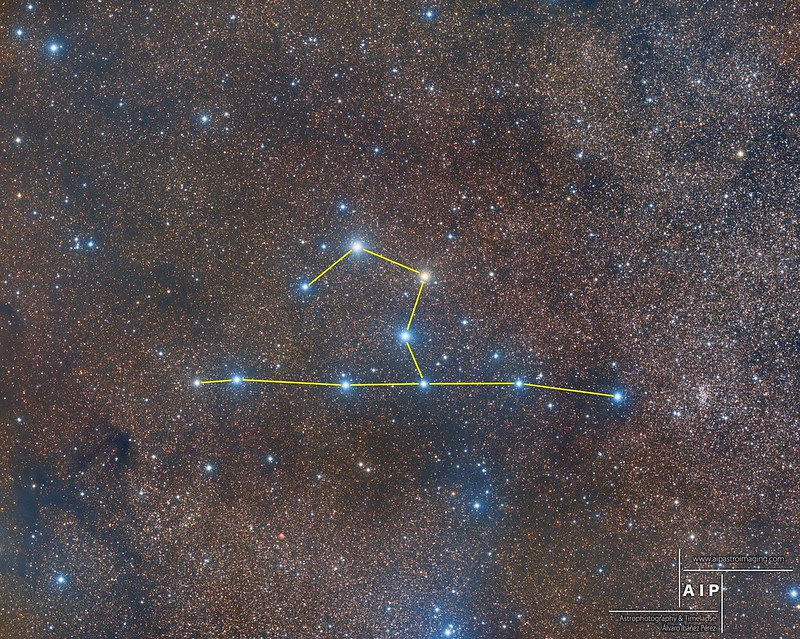
Autor: Álvaro Ibáñez Pérez
Website: www.aipastroimaging.com
Full resolution:
https://aipastroimaging.com/wp-content/ ... 00_AIP.jpg

Annotated:
https://c2.staticflickr.com/2/1801/2940 ... 9349_o.png

Telescope: Takahashi FSQ106EDX f/3,6-f/5
Mounts: Takahashi EM400 Temma-2, NEQ6 Pro II Tuning Belts
Camera: Atik 16200 monochrome
Filter Wheel: SX USB Filter Wheel 5x50,8mm
Filters: Astrodon Gen2 LRGB I-Series Tru-Balance 50,8mm
Guider: Lunático EZG-60 + SXLodestar
www.aipastroimaging.com
Mounts: Takahashi EM400 Temma-2, NEQ6 Pro II Tuning Belts
Camera: Atik 16200 monochrome
Filter Wheel: SX USB Filter Wheel 5x50,8mm
Filters: Astrodon Gen2 LRGB I-Series Tru-Balance 50,8mm
Guider: Lunático EZG-60 + SXLodestar
www.aipastroimaging.com
-
astroavani
- Ensign
- Posts: 18
- Joined: Thu Jun 28, 2018 3:53 am
Wandering behind the rings of Saturn
Which was not my surprise when processing the photo and discovering that it had captured the star HD 168233 exactly between the C-ring and the limb of Saturn.
This star has magnitude estimated at +9.25 and I never thought it would stand out so well due to the brightness of the rings and the planet itself.
Despite the interval of only 4 minutes, it is possible to see the movement from one photo to another.
Sorry for the poor viewing conditions, but still an interesting photo that leaves us quite happy with the result!
https://www.astrobin.com/full/355428/0/?nc=user
This star has magnitude estimated at +9.25 and I never thought it would stand out so well due to the brightness of the rings and the planet itself.
Despite the interval of only 4 minutes, it is possible to see the movement from one photo to another.
Sorry for the poor viewing conditions, but still an interesting photo that leaves us quite happy with the result!
https://www.astrobin.com/full/355428/0/?nc=user
Re: Submissions: 2018 July
Re: Submissions: 2018 July
IC 348, Barnard 3, LBN 749 and others
http://www.distant-lights.at/ic348-2017_10_16.htm
Copyright: Thomas Henne
http://www.distant-lights.at/ic348-2017_10_16.htm
Copyright: Thomas Henne
-
Steve Pastor
- Ensign
- Posts: 26
- Joined: Mon Jun 20, 2016 5:20 pm
Re: Submissions: 2018 July
The Whale Galaxy in Canes Venatici
NGC 4631 is found in the constellation Canes Venatici. The wedge-shape of this galaxy gives rise to its nickname, the Whale Galaxy. The starburst regions of this galaxy can be seen in the photo, which are due to intensive star formation. Tidal interactions of NGC 4627, which is seen just above NGC 4631, has been suggested as one of the reasons for the active core of NGC 4631 (as well as tidal interactions with other nearby galaxies). The small edge-on galaxy at the top of the image is PGC 3794315 (NASA Extragalactic Database). Total of 5 hr 40 min exposure taken with an SBIG STF8300c CCD camera and a 12.5 inch RCOS f/9 astrograph operating at f/6 (Astro-Physics CCDT067 reducer) mounted on a Paramount ME on the nights of 8, 15, 16 May 2018 in Mayhill, New Mexico (17 x 1200 sec Lights @ -15 degrees C; 15 darks; 128 bias; 128 flats). Processed with PixInsight 1.8.5.1353 Ripley (x64).
For a large image see: http://astronomersgroup.org/gallery/dis ... fullsize=1
NGC 4631 is found in the constellation Canes Venatici. The wedge-shape of this galaxy gives rise to its nickname, the Whale Galaxy. The starburst regions of this galaxy can be seen in the photo, which are due to intensive star formation. Tidal interactions of NGC 4627, which is seen just above NGC 4631, has been suggested as one of the reasons for the active core of NGC 4631 (as well as tidal interactions with other nearby galaxies). The small edge-on galaxy at the top of the image is PGC 3794315 (NASA Extragalactic Database). Total of 5 hr 40 min exposure taken with an SBIG STF8300c CCD camera and a 12.5 inch RCOS f/9 astrograph operating at f/6 (Astro-Physics CCDT067 reducer) mounted on a Paramount ME on the nights of 8, 15, 16 May 2018 in Mayhill, New Mexico (17 x 1200 sec Lights @ -15 degrees C; 15 darks; 128 bias; 128 flats). Processed with PixInsight 1.8.5.1353 Ripley (x64).
For a large image see: http://astronomersgroup.org/gallery/dis ... fullsize=1
- AlexMaragos
- Ensign
- Posts: 83
- Joined: Tue Jan 04, 2011 4:02 pm
- AKA: Alexandros Maragos
- Location: In transit
- Contact:
Re: Submissions: 2018 July
The summer Milky Way rise over the peaks of Mount Parnassus, Greece, on July 4, 2018.
According to Greek mythology, the mountain was sacred to Dionysus and the Dionysian mysteries.
It was also sacred to Apollo and the Corycian nymphs, and it was the home of the Muses.
https://alexandrosmaragos.com
Copyright: Alexandros Maragos

The Milky Way over Mount Parnassus, Greece by Alexandros Maragos
According to Greek mythology, the mountain was sacred to Dionysus and the Dionysian mysteries.
It was also sacred to Apollo and the Corycian nymphs, and it was the home of the Muses.
https://alexandrosmaragos.com
Copyright: Alexandros Maragos

The Milky Way over Mount Parnassus, Greece by Alexandros Maragos
-
mdieterich
- Ensign
- Posts: 99
- Joined: Fri Feb 13, 2015 5:50 pm
Re: Submissions: 2018 July
Dumbbell Nebula in Ha and Oiii
www.mdieterichphoto.com
Copyright: Matt Dieterich
The Dumbbell Nebula was the first discovered planetary nebula. This beautiful nebula was discovered way back in 1764 by Charles Messier. Planetary nebulae form as dying stars expand and shed layers of gas into space. The light captured here traveled about 1,200 light years before reaching the telescope and camera! The image represents a total of 16.6 hours of exposure using special filters to pass only narrow portions of hydrogen and oxygen gas emitted by the nebula. What I love about narrowband filters is that you can understand basic chemistry of the target by looking at the colors. The red is hydrogen and the blue is oxygen in this image. Shot using a PlaneWave CDK17 and L500 mount.
https://c2.staticflickr.com/2/1829/4267 ... 302a_h.jpg
www.mdieterichphoto.com
Copyright: Matt Dieterich
The Dumbbell Nebula was the first discovered planetary nebula. This beautiful nebula was discovered way back in 1764 by Charles Messier. Planetary nebulae form as dying stars expand and shed layers of gas into space. The light captured here traveled about 1,200 light years before reaching the telescope and camera! The image represents a total of 16.6 hours of exposure using special filters to pass only narrow portions of hydrogen and oxygen gas emitted by the nebula. What I love about narrowband filters is that you can understand basic chemistry of the target by looking at the colors. The red is hydrogen and the blue is oxygen in this image. Shot using a PlaneWave CDK17 and L500 mount.
https://c2.staticflickr.com/2/1829/4267 ... 302a_h.jpg
Last edited by bystander on Fri Jul 13, 2018 10:27 pm, edited 1 time in total.
Reason: Please, no hotlinks to images > 500Kb. Substituted smaller image.
Reason: Please, no hotlinks to images > 500Kb. Substituted smaller image.
Re: Submissions: 2018 July
Tulip Nebula with Cygnus X-1 Bow Shock
Ha/OIII bi-color with separate RGB star colors.
Nick Pavelchak
Altamont, NY
https://www.astrobin.com/355681/B/?nc=
Ha/OIII bi-color with separate RGB star colors.
Nick Pavelchak
Altamont, NY
https://www.astrobin.com/355681/B/?nc=
Re: Submissions: 2018 July
Deep Image of Peculiar Shell Elliptical Galaxy NGC 3923 in Hydra
http://www.rolfolsenastrophotography.com
Copyright: Rolf Wahl Olsen
Link to large image: https://www.rolfolsenastrophotography.c ... t3tLKx4/X5
Some 90 million light years away, towards the Southern constellation Hydra, lies the peculiar shell elliptical galaxy NGC 3923. As of 2018, there doesn't seem to exist any other amateur images of this beautiful galaxy.
Its unusual appearance originate from past mergers with other nearby galaxies which have generated the myriad of concentric shells visible near the centre. This phenomenon is in fact not uncommon and many other elliptical galaxies host large shell systems, including the famous Centaurus A (NGC 5128), but the remarkable symmetry and large number of subtle shells is unique to NGC 3923.
The formation of such shells are a common observation in computer simulations of merging galaxies.
The shells form when the cores of merging galaxies orbit around their common centre of mass in an ever tighter orbit while disrupting the halos of both galaxies and sending billions of stars into eccentric orbits. This process creates outward traveling density waves until the collision eventually settles as one single large galaxy.
Recent research based on deep images from the Canada-France-Hawaii Telescope have documented 42 concentric shells in NGC 3923, more than in any other known galaxy.
A prominent stream of stars is extending towards the lower right, terminating abruptly in a shell-like fragment (4 o'clock position). Visible within this stream is a small round galaxy, believed to be one of the merging progenitors of the shell system. The galaxy appears to be in the process of falling back towards the centre of NGC 3923, showing an almost comet-like tail of stars extending behind it.
Scattered throughout the field of view, far in the distant background, are numerous other individual galaxies and galaxy groups. Some are even visible through the diffuse glow from NGC 3923. Many lie several billion light years away and are visibly reddened by relativistic redshift caused by the expansion of the Universe.
Image details:
Date: 2018: 21st, 22nd, 24th, 25th, 29th, 31st May 2017
29th Jun 2017
15th, 16th, 23rd, 24th Feb 2018
9th, 25th March 2018
Exposure: LRGB: 1963:175:180:180 mins, total 41 hours 38 mins @ -25C
Telescope: Homebuilt 12.5" f/4 Serrurier Truss Newtonian
Camera: QSI 683wsg with Lodestar guider
Filters: Astrodon LRGB E-Series Gen 2
Taken from my observatory in Auckland, New Zealand
http://www.rolfolsenastrophotography.com
Copyright: Rolf Wahl Olsen
Link to large image: https://www.rolfolsenastrophotography.c ... t3tLKx4/X5
Some 90 million light years away, towards the Southern constellation Hydra, lies the peculiar shell elliptical galaxy NGC 3923. As of 2018, there doesn't seem to exist any other amateur images of this beautiful galaxy.
Its unusual appearance originate from past mergers with other nearby galaxies which have generated the myriad of concentric shells visible near the centre. This phenomenon is in fact not uncommon and many other elliptical galaxies host large shell systems, including the famous Centaurus A (NGC 5128), but the remarkable symmetry and large number of subtle shells is unique to NGC 3923.
The formation of such shells are a common observation in computer simulations of merging galaxies.
The shells form when the cores of merging galaxies orbit around their common centre of mass in an ever tighter orbit while disrupting the halos of both galaxies and sending billions of stars into eccentric orbits. This process creates outward traveling density waves until the collision eventually settles as one single large galaxy.
Recent research based on deep images from the Canada-France-Hawaii Telescope have documented 42 concentric shells in NGC 3923, more than in any other known galaxy.
A prominent stream of stars is extending towards the lower right, terminating abruptly in a shell-like fragment (4 o'clock position). Visible within this stream is a small round galaxy, believed to be one of the merging progenitors of the shell system. The galaxy appears to be in the process of falling back towards the centre of NGC 3923, showing an almost comet-like tail of stars extending behind it.
Scattered throughout the field of view, far in the distant background, are numerous other individual galaxies and galaxy groups. Some are even visible through the diffuse glow from NGC 3923. Many lie several billion light years away and are visibly reddened by relativistic redshift caused by the expansion of the Universe.
Image details:
Date: 2018: 21st, 22nd, 24th, 25th, 29th, 31st May 2017
29th Jun 2017
15th, 16th, 23rd, 24th Feb 2018
9th, 25th March 2018
Exposure: LRGB: 1963:175:180:180 mins, total 41 hours 38 mins @ -25C
Telescope: Homebuilt 12.5" f/4 Serrurier Truss Newtonian
Camera: QSI 683wsg with Lodestar guider
Filters: Astrodon LRGB E-Series Gen 2
Taken from my observatory in Auckland, New Zealand
Re: Submissions: 2018 July
The Incas' Llama dark cloud constellation
The Incas' dark cloud constellation of the Llama in high resolution (21 tiles mosaic project, more than 40 hours of exposure time in total).
http://www.bastienfoucher.com
Copyright: Bastien Foucher https://photos.smugmug.com/Other/Images ... SjNR-L.jpg
A higher resolution of the picture is available here : https://photos.smugmug.com/Astrophotogr ... O/lama.jpg
Even higher resolution versions of the picture are available on request (the final file size is 80 mpix).
Edit : Sorry for the big hotlink image It is now repaired.
It is now repaired.
The Incas' dark cloud constellation of the Llama in high resolution (21 tiles mosaic project, more than 40 hours of exposure time in total).
http://www.bastienfoucher.com
Copyright: Bastien Foucher https://photos.smugmug.com/Other/Images ... SjNR-L.jpg
A higher resolution of the picture is available here : https://photos.smugmug.com/Astrophotogr ... O/lama.jpg
Even higher resolution versions of the picture are available on request (the final file size is 80 mpix).
Edit : Sorry for the big hotlink image
Last edited by Goudig on Sun Jul 15, 2018 11:23 am, edited 2 times in total.
Re: Submissions: 2018 July
OK, I had a daft idea yesterday. It struck me that all planets, dwarf included, are huddled on this side of the sun and potentially visible at some point during the night.
So on Brisbane Australia's coldest night of the year so far, I pulled an all-nighter
I did plan to do a nice wide field observatory shot for "Earth" but at 5am I was just too knackered so you're stuck with a selfie which is all I could manage.
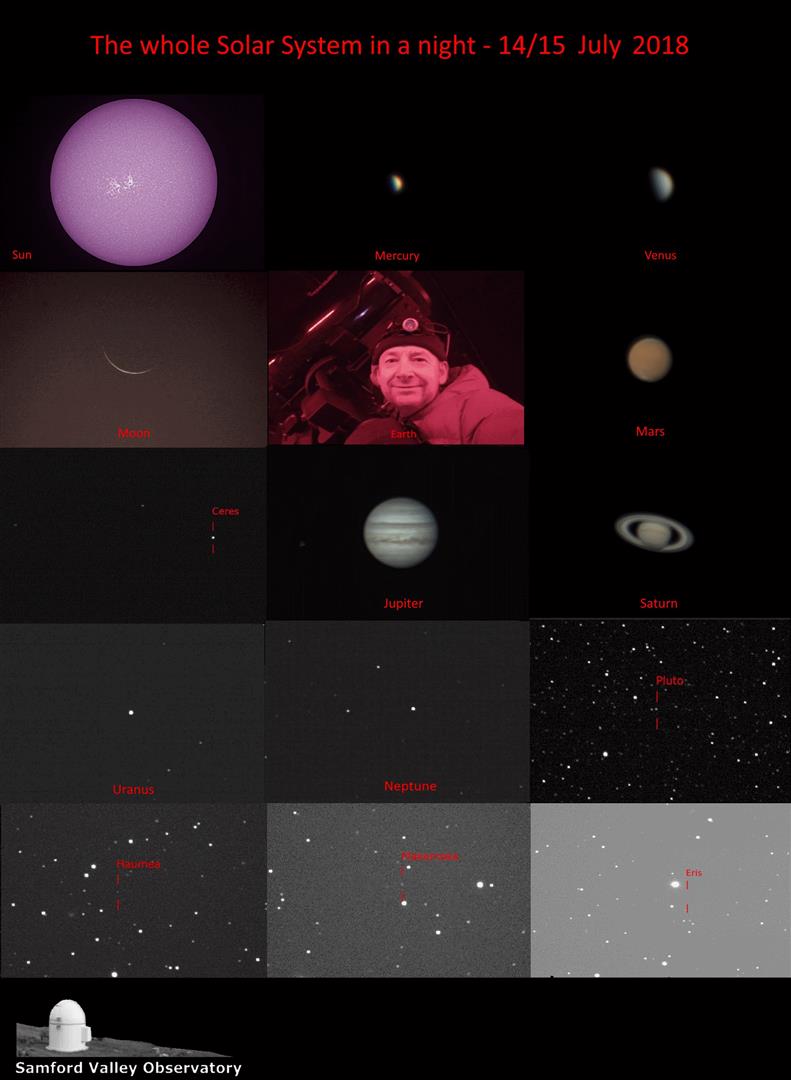
Taken at The Samford Valley Observatory (Q79) Australia by the bloke in the photo - Jonathan Bradshaw!
So on Brisbane Australia's coldest night of the year so far, I pulled an all-nighter
I did plan to do a nice wide field observatory shot for "Earth" but at 5am I was just too knackered so you're stuck with a selfie which is all I could manage.

Taken at The Samford Valley Observatory (Q79) Australia by the bloke in the photo - Jonathan Bradshaw!
-
KuriousGeorge
- Science Officer
- Posts: 218
- Joined: Wed Dec 30, 2015 7:07 am
- Location: San Diego, CA
- Contact:
Re: Submissions: 2018 July
NGC 5907 with Tidal Stream. Copyright KG Observatory, Julian CA.
I started this project with the goal to capture the very faint tidal streams that R. Jay Gabany captured at a very dark site in New Mexico 12 years ago (June through August 2006).
After a week, I concluded that my 21.5 average sky was no match for his 21.8+ sky at the time. Although our equipment is similar, I would need the marine layer cover over San Diego to see a 21.8+ sky. Unfortunately the marine layer was not present as I expected.
Nevetheless, I'm happy with the results. What you see here is the same stretch applied to both the galaxy and the tidal stream. With that, you can see the relative brightness difference and the extensive glow around NGC 5907 that I have not seen in similar attempts at this very elusive galaxy/tidal stream pair. I hope you enjoy it!
P.S. The glow at the bottom left is from a very bright out-of-frame star. Although I toned it down a bit, it was too difficult to completely eliminate without damaging the surrounding data. We're still studying the cause.
https://www.astrobin.com/356153/
I started this project with the goal to capture the very faint tidal streams that R. Jay Gabany captured at a very dark site in New Mexico 12 years ago (June through August 2006).
After a week, I concluded that my 21.5 average sky was no match for his 21.8+ sky at the time. Although our equipment is similar, I would need the marine layer cover over San Diego to see a 21.8+ sky. Unfortunately the marine layer was not present as I expected.
Nevetheless, I'm happy with the results. What you see here is the same stretch applied to both the galaxy and the tidal stream. With that, you can see the relative brightness difference and the extensive glow around NGC 5907 that I have not seen in similar attempts at this very elusive galaxy/tidal stream pair. I hope you enjoy it!
P.S. The glow at the bottom left is from a very bright out-of-frame star. Although I toned it down a bit, it was too difficult to completely eliminate without damaging the surrounding data. We're still studying the cause.
https://www.astrobin.com/356153/
Re: Submissions: 2018 July
Moon and Venus Conjunction
http://www.deepskyobjects.com/Other/Moon_Venus_g.asp
Copyright: Behyar Bakhshandeh, Carlsbad, CA
http://www.deepskyobjects.com/
http://www.deepskyobjects.com/Other/Moon_Venus_g.asp
Copyright: Behyar Bakhshandeh, Carlsbad, CA
http://www.deepskyobjects.com/
Mars and the Capricorn
Panorama of Mars rising in eastern sky, captured near Parkes, NSW, Australia on Friday 13th July 2018.
Phil
Phil
-
strongmanmike
The Fighting Dragons of Ara
The Fighting Dragons of Ara (NGC 6188), tussling over the gem encrusted magic egg complete with its mystical halo (NGC 6164), is a beautiful area of the Milky Way in the southern constellation of Ara. This 4deg X 4deg field also captures several star clusters and a few planetary nebulae...can you find them..? 
Large file here: https://www.flickr.com/photos/strongman ... ed-public/
Copyright: Michael Sidonio
Large file here: https://www.flickr.com/photos/strongman ... ed-public/
Copyright: Michael Sidonio


